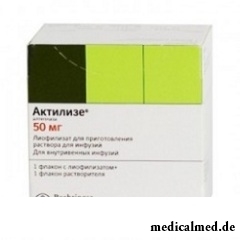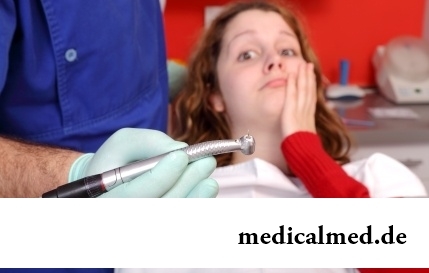





To Aktiliza
Application instruction:
 To Aktiliza – тромболитик, recombinant human fabric a plasminogen activator; the glycoprotein which is directly activating transformation of plasminogen to plasmin.
To Aktiliza – тромболитик, recombinant human fabric a plasminogen activator; the glycoprotein which is directly activating transformation of plasminogen to plasmin.
Form of release and structure
Dosage form – lyophilisate for preparation of solution for infusions: white or pale yellow weight (on 50 mg of lyophilisate and 50 ml of solvent in bottles of colourless glass, in a cardboard box 1 bottle with lyophilisate complete with 1 bottle of solvent).
To Aktiliza contains in 1 bottle:
- Active ingredient: an alteplaza – 50 mg (in 1 ml of ready solution of 1 mg);
- Auxiliary components: L-arginine, polysorbate 80, phosphoric acid, gentamycin (residual traces after production process).
Solvent: water for injections – 50 ml.
Indications to use
Use is shown to Aktiliza as a part of thrombolytic therapy of the following diseases / states:
- Acute myocardial infarction;
- The massive thromboembolism of a pulmonary artery which is followed by an unstable hemodynamics;
- Acute period of an ischemic stroke.
Contraindications
- Period of pregnancy and breastfeeding;
- Children's and teenage age up to 18 years;
- Hypersensitivity to drug components.
Contraindications for patients with the increased risk of development of bleedings:
- Hemorrhagic diathesis;
- Extensive bleeding, including during the last 6 months;
- Aneurism, new growths and other pathologies of the central nervous system in the anamnesis, including surgery on a head or spinal cord;
- Suspicion of a hemorrhagic stroke;
- Intracranial (including subarachnoidal) hemorrhage, including in the anamnesis;
- Heavy uncontrollable arterial hypertension;
- Simultaneous therapy by warfarin and other peroral anticoagulants;
- Severe injury, extensive surgical intervention during ten previous days, including any injury got against the background of the developing myocardial infarction;
- Puncture of incompressible blood vessels (including a subclavial or jugular vein) made recently;
- Traumatic or long (more than 2 minutes) cardiopulmonary resuscitation;
- The craniocereberal injury postponed recently;
- Childbirth during the previous 10 days;
- The expressed liver pathologies, such as cirrhosis, liver failure, active hepatitis, portal hypertensia (including with a gullet varicosity);
- Acute pancreatitis;
- Pericardis, bacterial endocarditis;
- The peptic ulcer of a stomach and duodenum diagnosed within the last 3 months;
- New growths with risk of bleeding;
- Defects of development of veins and arteries, arterial aneurisms.
Additional contraindications for use to Aktiliza at an acute myocardial infarction and an embolism of a pulmonary artery:
- Hemorrhagic stroke or stroke of unknown genesis in the anamnesis;
- The Tranzitorny ischemic attacks or ischemic stroke within the last 6 months (not including the first 4,5 hours of the current acute ischemic stroke).
Except above-mentioned contraindications, at an acute ischemic stroke Aktiliza cannot apply in the following cases:
- Weak expressiveness of symptoms of an acute ischemic stroke by the beginning of infusion or bystry improvement of a condition of the patient;
- Lack of exact data on time of the beginning of a disease, the period more than 4,5 hours from the moment of the first symptoms of an ischemic stroke prior to infusion;
- The heavy, clinically confirmed course of a stroke, for example, if an indicator on NIHSS scale (a scale of weight of a stroke of national institute of health) more than 25, or the corresponding results of a computer tomography or nuclear magnetic resonance are received;
- Serious injury of the head or the had stroke within three last months;
- Spasms at the beginning of a stroke;
- Emergence of the previous stroke at a diabetes mellitus;
- Reception of heparin within 48 hours to the first symptoms of a stroke, at the raised activated partial tromboplastinovy time (APTT) at present time;
- Quantity of thrombocytes less than 100 000 in мкл;
- The systolic arterial pressure (AP) over 185 mm hg or diastolic is higher than the ABP 110 mm hg, or in need of use of intensive hypotensive care (in/in administration of medicines) for pressure decrease to these borders;
- Concentration of glucose in blood is lower than 3 or higher than 20 mmol/l.
With care, only on the basis of preliminary estimate of degree of estimated advantage of therapy and risk of bleeding, Aktiliza should appoint the patient after recent insignificant intervention with a needle at a biopsy or a puncture of large vessels, a cardiac massage at resuscitation, the executed intramuscular injection (in oil); at any diseases (which are not specified in the list of contraindications), connected with the increased risk of bleeding; in case of a concomitant use of peroral anticoagulants use of drug is shown only if anticoagulating activity according to laboratory researches is not clinically significant.
At an acute myocardial infarction and an acute embolism of a pulmonary artery in addition it is necessary to be careful at treatment of patients with the systolic ABP higher than 160 mm of mercury. and patients of advanced age as at them the risk of intracraneal hemorrhage can increase.
As the probability of positive clinical effect of this therapy at patients of advanced age rather high, despite the specified negative side effects, is required to compare estimated advantage and risk carefully.
At an acute ischemic stroke use to Aktiliza is followed by the increased threat of intracraneal hemorrhage as preferential it occurs to the necrotic area. In this connection it is required to consider in addition existence at patients of the following features:
- The pathologies connected with high risk of bleeding;
- Insignificant asymptomatic aneurisms of cerebral vessels;
- The delay began therapies;
- The previous therapy by acetylsalicylic acid or other antiagregantny substances / drugs increase risk of intracerebral bleeding, especially at later terms of an initiation of treatment (the dose of an alteplaza has to make no more than 0,9 mg on 1 kg of weight of the patient a day);
- The senile age more than 80 years, increases risk of brain hemorrhage and the general advantage of therapy decreases.
It is impossible to begin treatment alteplazy 4,5 hours later from the moment of emergence of symptoms of a disease as it leads to decrease in positive effect, increase in mortality against the background of preliminary therapy by acetylsalicylic acid and risk of bleeding.
Route of administration and dosage
Lyophilisate is intended for preparation of solution for infusions by dissolution of contents of 1 bottle (50 mg) of drug in 1 bottle (50 ml) of solvent.
It is necessary to mix before full dissolution carefully, avoiding strong agitation not to allow foaming. Liquid has to have transparent colourless structure of pale yellow color without any particles.
For additional cultivation it is possible to use 0,9% chloride sodium solution.
The minimum concentration of an alteplaza in solution for infusions has to make 0,2 mg/ml.
It is impossible to dissolve further originally received solution with solution for infusions on the basis of carbohydrates or water for injections, and also to mix with other medicines in system for in/in introductions.
Aktiliza should begin use at emergence of the first symptoms of a disease.
The recommended dosing mode:
- Myocardial infarction, at the begun treatment within 6 hours after development of symptoms: the accelerated therapy mode – in/in struyno in a dose of 15 mg, then infusion within 30 minutes in a dose of 50 mg, in the next 60 minutes – 35 mg, the general maximum dose of 100 mg. Patient weighing up to 65 kg: in/in struyno – 15 mg, then in/in kapelno – from calculation for 0,75 mg on 1 kg of body weight (no more than 50 mg) within 30 minutes, in the next 60 minutes to the patient enter a dose on 0,5 mg on 1 kg (no more than 35 mg);
- Myocardial infarction, at an initiation of treatment during the period between 6 and 12 hours from the moment of development of symptoms: the three-hour mode of dosing – in/in struyno 10 mg, then in/in kapelno 50 mg within 60 minutes, further on 10 mg each next 30 minutes before achievement of the maximum total dose of 100 mg. For patients weighing up to 65 kg the dose is appointed from calculation for 1,5 mg to 1 kg of weight of the patient;
- Thromboembolism of a pulmonary artery: at first within 1-2 minutes in/in struyno – 10 mg, then in/in kapelno within 120 minutes – 90 mg, a total dose of 100 mg. Weighing patient up to 65 kg – no more than 1,5 mg on 1 kg;
- The acute period of an ischemic stroke (within the first 4,5 hours, it is necessary to begin treatment as soon as possible after emergence of the first symptoms): from calculation for 0,9 mg on 1 kg of weight of the patient (no more than 90 mg) from which 10% – in/in struyno, then other amount of the drug administer in/in kapelno within 60 minutes. What began treatment in the specified span, with that a high probability of favorable result of therapy earlier.
Antitrombotichesky auxiliary therapy according to the international recommendations is shown to patients with a myocardial infarction when raising a segment of ST.
After introduction Aktiliz auxiliary therapy at a thromboembolism of a pulmonary artery in the form of infusional use of heparin can be required by patients in case of exceeding of AChTV less than twice over the inborn adrenal struma (IAS).
Within the first 24 hours after an initiation of treatment of an ischemic stroke it is necessary to avoid auxiliary therapy with use of acetylsalicylic acid or in/in administrations of heparin.
Side effects
The most frequent side effect of use to Aktiliza at a myocardial infarction, an embolism of a pulmonary artery or the acute period of an ischemic stroke is the bleeding leading to decrease in hemoglobin. It can occur in any cavity or a part of a body and to cause a zhizneugrozhayushchy situation, including with a lethal outcome.
Bleedings can be outside (from a nose, places of punctures, damages of blood vessels) and internal (bleedings in any cavity or a part of a body).
Drowsiness, aphasia, hemiparesis, spasms belongs to neurologic symptoms of intracranial bleeding.
Besides, use of drug at a myocardial infarction, an embolism of a pulmonary artery or the acute period of an ischemic stroke can become the reason of the following undesirable phenomena:
- Immune system: anaphylactoid reactions; perhaps – decrease in the ABP, a bronchospasm, a small tortoiseshell, a Quincke's disease, rash, other reactions of hypersensitivity, shock;
- Cardiovascular system: bleedings (in the form of a hematoma), pericardiac bleeding, embolisms, bleedings in parenchymatous bodies (intra hepatic bleeding, pulmonary bleeding);
- Nervous system: intracraneal hemorrhage – a cerebral hematoma, hemorrhage in a brain, a hemorrhagic stroke, an intracranial hematoma, hemorrhagic transformation of a stroke, subarachnoidal hemorrhage;
- Organ of sight: eye retinal apoplexies;
- Alimentary system: nausea, vomiting, an odontorrhagia, a hematemesis, bleeding from an oral cavity, a stomach helcomenia, gastric bleeding, a proctorrhagia, a melena, retroperitoneal bleeding (a retroperitoneal hematoma);
- Respiratory system: pneumorrhagia, pharyngorrhagia or nose;
- Urinary system: bleedings from urinary tract, a hamaturia;
- Dermatological reactions: ecchymomas;
- Local reactions: bleedings in the place of injections, a hematoma, bleedings in the place of punctures;
- Others: fervescence, decrease in the ABP, fatty embolism, need for transfusions.
At treatment of a myocardial infarction development of additional undesirable effects from cardiovascular system is possible – reperfusion arrhythmias: tachycardia, premature ventricular contraction, arrhythmia, a ciliary arrhythmia, bradycardia, atrioventricular (AV) blockade from the I degree to a total block, ventricular arrhythmia, ventricular tachycardia, fibrillation of ventricles, a cardiac standstill, a lethal outcome.
Special instructions
Aktiliza should carry out use in the conditions of a hospital, in the presence of the standard resuscitation equipment and the corresponding medicines, under control of the doctor with experience of performing thrombolytic therapy.
Infusion is required to be accompanied with regular control of portability of treatment, especially at simultaneous use of inhibitors of an angiotensin-converting enzyme (APF). At development of anaphylactoid reaction administration of drug is stopped.
As bleeding is a frequent complication of therapy it is necessary to avoid use in oil of injections, rigid catheters, unreasonable manipulations during treatment and to watch carefully zones of possible bleeding.
Developing of bleeding can be promoted by simultaneous use of heparin. In case of development of bleeding against the background of reception of heparin within 4 next few hours the patient should appoint protamin.
At cerebral and other heavy bleedings fibrinolitic therapy and use of heparin needs to be cancelled. In case of lack of clinical effect of conservative measures for a stop of bleeding therapy is shown by blood preparations (cryoprecipitate, freshly frozen plasma and thrombocytes).
The diagnosis of a thromboembolism of a pulmonary artery demands objective confirmation by an angiography of a pulmonary artery or a tomography of lungs.
It is clinically confirmed that at an acute myocardial infarction use Aktiliz promotes decline in mortality in the first 30 days of a disease.
At treatment of an acute myocardial infarction the risk of bleeding is increased by the accompanying therapy by antagonists of a glycoprotein of IIb/IIIa, thromboembolisms – use of thrombolytic means at patients with thrombosis of the left departments of heart. The coronary thrombolysis can cause the arrhythmia connected with reperfusion.
Treatment of an ischemic stroke in the acute period should be begun only after an exception of intracranial bleeding by means of a computer or magnetic and resonant tomography of a brain.
At an acute ischemic stroke the clinical effect of therapy is lower at the patients who earlier had a stroke with the accompanying uncontrollable diabetes mellitus.
It is not recommended to apply to Aktiliza at a stroke with easy severity as potential risk from use of drug above the expected advantage.
Because of big risk of intracraneal hemorrhage and a lethal outcome the alteplaz is not recommended to apply at a severe form of a stroke.
Resuming of a blood-groove of ischemic area can cause wet brain in a heart attack zone. Because of high risk of hemorrhages it is not necessary to begin use of antiagregant within 24 hours after use of an alteplaza.
Medicinal interaction
The medicines changing function of thrombocytes or influencing a blood coagulation can increase risk of bleeding.
The risk of development of anaphylactoid reactions increases at simultaneous use with alteplazy APF inhibitors.
Terms and storage conditions
To store in the place protected from light at a temperature up to 25 °C. To protect from children.
Period of validity – 3 years.
In the refrigerator, at a temperature of 2-8 °C, it is possible to preserve solution, ready to infusion, 24 hours; at a temperature up to 25 °C – no more than 8 hours.
The well-known drug "Viagra" was initially developed for treatment of an arterial hypertension.

The climax, or menopause is the normal process of the termination of genital function of the woman which is followed serious hormonal...
Section: Articles about health
Turnip, radish, horse-radish – once these and other products enjoyed wide popularity at our ancestors, being not only the food sating an organism but also the medicines curing of many diseases. Unfortunately, having given the use of some of them...
Section: Articles about health
An eye of the person daily experiences considerable strain. The problem of preservation of sight is for many years directly connected with a question of supply of tissues of eye enough oxygen and nutrients. This task is carried out by small vessels – capillaries. For normal functioning of the visual device extremely important that they kept the integrity, but it works well not always. Microtraumas of eye vessels during which there are small hemorrhages it is extraordinary расп...
Section: Articles about health
Statistically, can only one of ten of our compatriots brag of a decent condition of an oral cavity. On среднестатистич...
Section: Articles about health
All are familiar with cold, and practically everyone believes that he has sufficient knowledge and experience that correctly to treat it. In practice most of people makes mistakes in attempts to get rid of rhinitis, and divides numerous delusions it....
Section: Articles about health
The Genetically Modified Organisms (GMO) are plants or animals (as a rule, agricultural) to whose genotype purposeful changes were made. Opposition of supporters and opponents of inclusion of such organisms in foodstuff always was very acute. Not only scientists and dietitians, but also a large number of the people who are not specialists in this question are involved in active disputes today....
Section: Articles about health
Osteoporosis this general disease which main sign is decrease in density of a bone tissue. On width распростран...
Section: Articles about health
The mankind knows that some toxins at intake in the minimum quantities have therapeutic effect from an extreme antiquity. Many substances recognized poisonous are applied in the medical purposes also today, being the main deystvuyushch...
Section: Articles about health
It seems, quite recently you brought the baby from maternity hospital, but time flew by, and here it is already going to join the first in life children's collective. How to prepare the child for visit of a garden? What needs to teach him to facilitate adaptation process? What to tell and how to behave that the kid transferred changes in the life without serious consequences? Let's try to find answers to these questions....
Section: Articles about health
To look healthy and means well-groomed not only to be pleasant to people around, but also to feel strong, sure and taken place. To Spa...
Section: Articles about health
Musicotherapy – a treatment method which caused and causes a set of a controversy concerning its efficiency. However the facts are relentless: during the numerous researches curative impact of music on an organism was scientifically confirmed. Since then in a number of the countries a method...
Section: Articles about health
For anybody not a secret that our country is one of the most "drinking" in the world. At clear understanding that the use of hard alcoholic drinks – occupation extremely harmful, most of Russians belong to alcoholism with unjustified loyalty. Apparently, existence of a set of myths in which tendency to excessive libations looks nearly positively is explained by it. It is worth getting acquainted with the most widespread of similar delusions and to be convinced in them not...
Section: Articles about health
According to doctors, more than a half of men of 25-50 years suffer from frustration of the urinogenital sphere, but sees a doctor from them меньшинс...
Section: Articles about health
Obesity is called a disease of 21 centuries, for the last 100 years the number of the people suffering from excess body weight considerably increased. Statistically, on Earth already about 1,5 billion corpulent people, and 500 million from them have extreme degree of completeness, are negative...
Section: Articles about health
The majority of gynecologic diseases prove three main signs, each of which speaks about need of a visit to the gynecologist. Certainly, it is possible to establish the exact diagnosis only after inspection, but on the basis of some signs it is possible to assume existence of this or that pathology. Let's consider symptoms of the female diseases which are found most often....
Section: Articles about health
Healthy lifestyle today in fashion, and many parents think of that the child from the early childhood played sports. To a Torah...
Section: Articles about health
Neurosis is called pathology of a nervous system at which deviations in functioning of the highest nervous processes are observed. Most often - owing to yet not strengthened mentality - children are subject to neurosises. Premises to emergence of such disturbances can become нез...
Section: Articles about health
Condition of lips (their morbidity, outward) – one of indicators of health of the person. The peeling, dryness, pallor, and also cracks in corners of a mouth can be not only the cosmetic shortcoming which arose owing to physical damages and weather conditions but also the satellite of some diseases and disturbances in an organism needing treatment. Let's consider 10 possible reasons of emergence of angular cracks (perleches) in corners of a mouth and ways of their elimination....
Section: Articles about health
One of the major chemical processes happening in a human body are oxidation reactions. They go with participation of fats...
Section: Articles about health
Ability of an organism to resist to adverse environmental factors (to impact of temperature drops, humidity and pressure, to the attacks of causative organisms, etc.) directly depends on what the person eats. Business here not only in, that C...
Section: Articles about health
According to data of World Health Organization, the cataract is diagnosed almost for 7% of the population of Earth. The statistics of incidence is considered not full as at an initial stage the illness, as a rule, does not cause to the person of special inconveniences, and many diseased sees doctors not at once. The cataract is not only one of the most widespread ophthalmologic illnesses, but also the reason of a half of cases of loss of sight....
Section: Articles about health
Life of the modern woman is very difficult. Opportunities to realize itself are wide: it not only education and career, but also most differently...
Section: Articles about health
For the city dweller the fitness is the most convenient sport. It is enough to acquire the subscription to the gym to get access to various apparatuses and an opportunity to train under the leadership of the experienced consultant. Many consider fitness on...
Section: Articles about health
About 20% of the population of our planet have a hypertension (permanent increase in arterial pressure). This disease has an adverse effect on the standard of living, reduces working capacity, and in the absence of systematic treatment threatens with such complications as a myocardial infarction, a stroke and other heavy illnesses which can result in disability or sudden death. Most of patients for maintenance of pressure at more or less acceptable level accept appointed doctors лекарст...
Section: Articles about health
Doctors claim that the people not so familiar with a dorsodynia occur among adult Russians very seldom. At the same time подавляющ...
Section: Articles about health
Any person who faced a disease knows that treatment costs expensive. It belongs also to consultations of qualified specialists, and to the diagnostic procedures which are not included in the list of obligatory medical services. Question of cost of medicinal Wednesday...
Section: Articles about health
Shops of household appliances offer us the huge choice of various devices for the house. Whether there are among this abundance devices which not only facilitate house work, but also help to keep health of the person? Of course, and we will tell about them today....
Section: Articles about health
